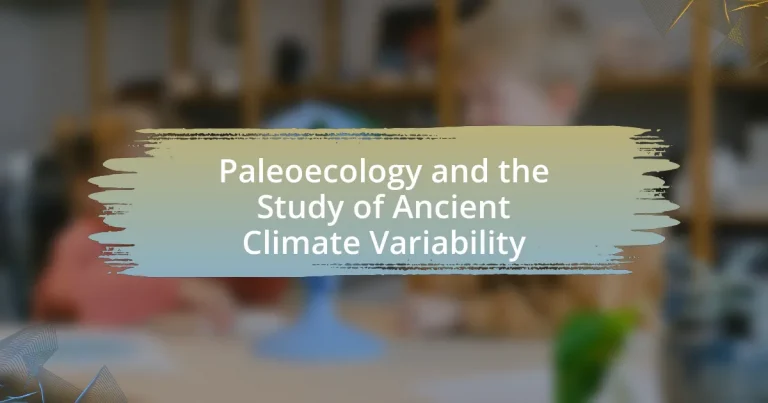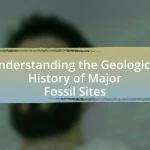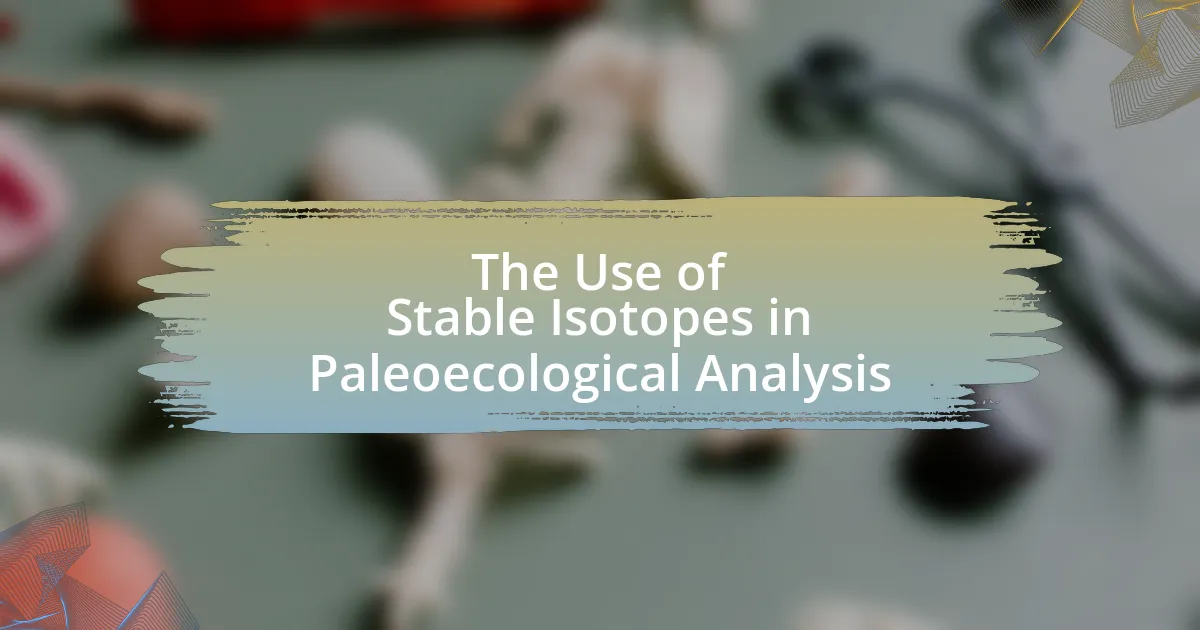Paleoecology is the scientific study of ancient ecosystems and environmental conditions, primarily through fossil records and sediment analysis. This field examines the interactions between ancient organisms and their environments, as well as the influence of climate variability over geological time. Key methods in paleoecology include sediment analysis, fossil records, and isotopic studies, which collectively help reconstruct past climates and ecosystems. Understanding ancient climate variability is crucial for predicting future climate scenarios and informing modern environmental policies, as it provides insights into natural climate processes and their impacts on biodiversity and human societies. The article explores the methodologies, challenges, and practical applications of paleoecological research, highlighting its significance in addressing contemporary climate change issues.
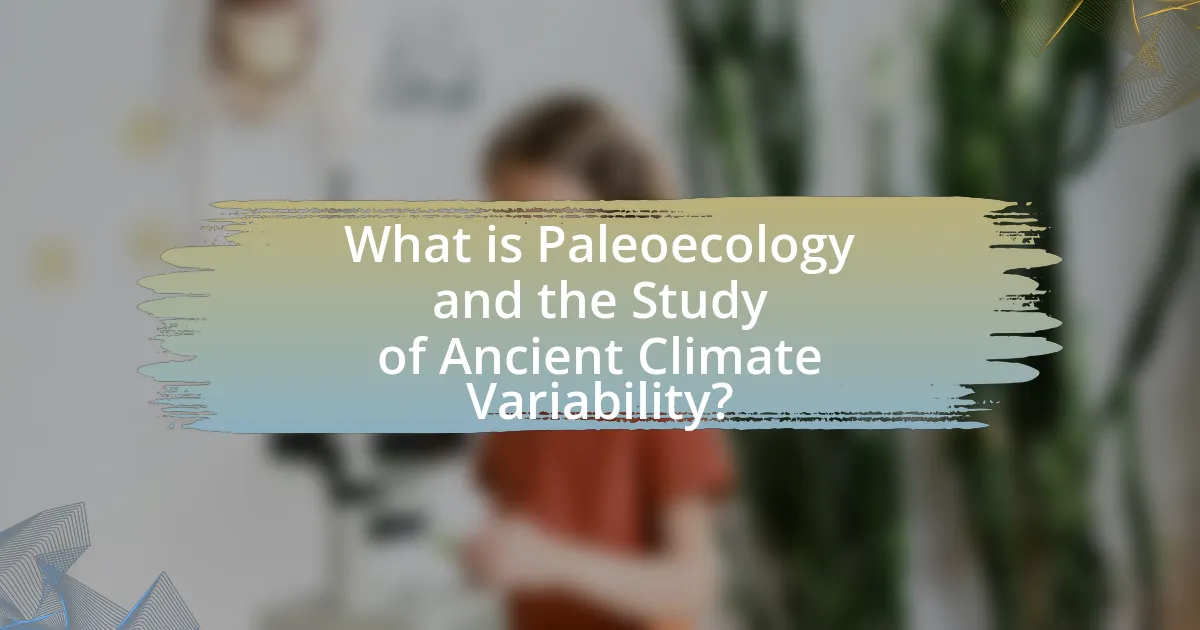
What is Paleoecology and the Study of Ancient Climate Variability?
Paleoecology is the scientific study of ecosystems and environmental conditions of the past, primarily through the analysis of fossil records and sediment samples. This field examines how ancient organisms interacted with their environments and how climate variability influenced these ecosystems over geological time scales. For instance, research has shown that during the last glacial maximum, approximately 20,000 years ago, significant shifts in vegetation and animal populations occurred in response to changing temperatures and ice cover, providing concrete evidence of climate’s impact on ecological dynamics.
How does paleoecology contribute to our understanding of ancient climates?
Paleoecology contributes to our understanding of ancient climates by analyzing fossilized remains and sedimentary records to reconstruct past ecosystems and climate conditions. This field utilizes data from pollen, plant remains, and isotopic analysis to infer temperature, precipitation patterns, and atmospheric composition during different geological periods. For instance, studies of sediment cores from lakes and ocean floors reveal changes in biodiversity and species distribution that correlate with climatic shifts, such as the transition from the last Ice Age to the current warm period. These insights help scientists understand the natural variability of Earth’s climate and the factors that drive long-term climate change.
What methods are used in paleoecology to study ancient climates?
Paleoecology employs several methods to study ancient climates, including sediment analysis, fossil records, and isotopic studies. Sediment analysis involves examining layers of soil and sediment to infer past environmental conditions, while fossil records provide insights into the types of organisms that existed and their adaptations to climate. Isotopic studies, particularly of oxygen and carbon isotopes, allow researchers to reconstruct temperature and precipitation patterns over geological time. These methods collectively enable scientists to build a comprehensive understanding of ancient climate variability and its impacts on ecosystems.
How do fossil records inform us about past climate conditions?
Fossil records inform us about past climate conditions by providing evidence of the types of organisms that existed in specific environments at different geological times. These organisms, including plants and animals, reflect the climate in which they lived; for example, the presence of certain tree species indicates warmer, wetter conditions, while the prevalence of marine fossils can suggest higher sea levels and different temperature ranges. Additionally, isotopic analysis of fossilized remains can reveal information about ancient temperatures and precipitation patterns, as seen in studies of oxygen isotopes in foraminifera, which indicate historical ocean temperatures. This data allows scientists to reconstruct past climates and understand how ecosystems responded to climate changes over millions of years.
Why is the study of ancient climate variability important?
The study of ancient climate variability is important because it provides insights into natural climate processes and their impacts on ecosystems and human societies. Understanding past climate changes, such as those identified through ice core data and sediment analysis, helps scientists predict future climate trends and assess potential risks. For example, research indicates that periods of significant climate shifts, like the Younger Dryas, led to drastic changes in biodiversity and human migration patterns. This historical context is crucial for developing effective climate adaptation strategies today.
What insights can ancient climate variability provide for current climate change?
Ancient climate variability offers critical insights into current climate change by revealing patterns of natural climate fluctuations and their impacts on ecosystems. For instance, studies of ice cores from Greenland and Antarctica indicate that temperature changes of several degrees occurred over centuries, demonstrating the Earth’s sensitivity to greenhouse gas concentrations. Additionally, sediment records from lakes and oceans show how species adapted or migrated in response to past climate shifts, providing a framework for understanding potential future ecological responses. These historical data points underscore the importance of considering long-term climate trends and biological responses when predicting the effects of contemporary climate change.
How does understanding past climates help in predicting future climate scenarios?
Understanding past climates is crucial for predicting future climate scenarios because it provides a baseline for assessing natural climate variability and human impacts. By analyzing historical climate data, such as temperature records, ice core samples, and sediment layers, scientists can identify patterns and trends that have occurred over millennia. For instance, the study of glacial and interglacial periods reveals how Earth’s climate has responded to changes in greenhouse gas concentrations, solar radiation, and volcanic activity. This historical context allows researchers to model future climate scenarios more accurately, as evidenced by the Intergovernmental Panel on Climate Change (IPCC) reports, which utilize paleoclimate data to project future warming trends and their potential impacts on ecosystems and human societies.
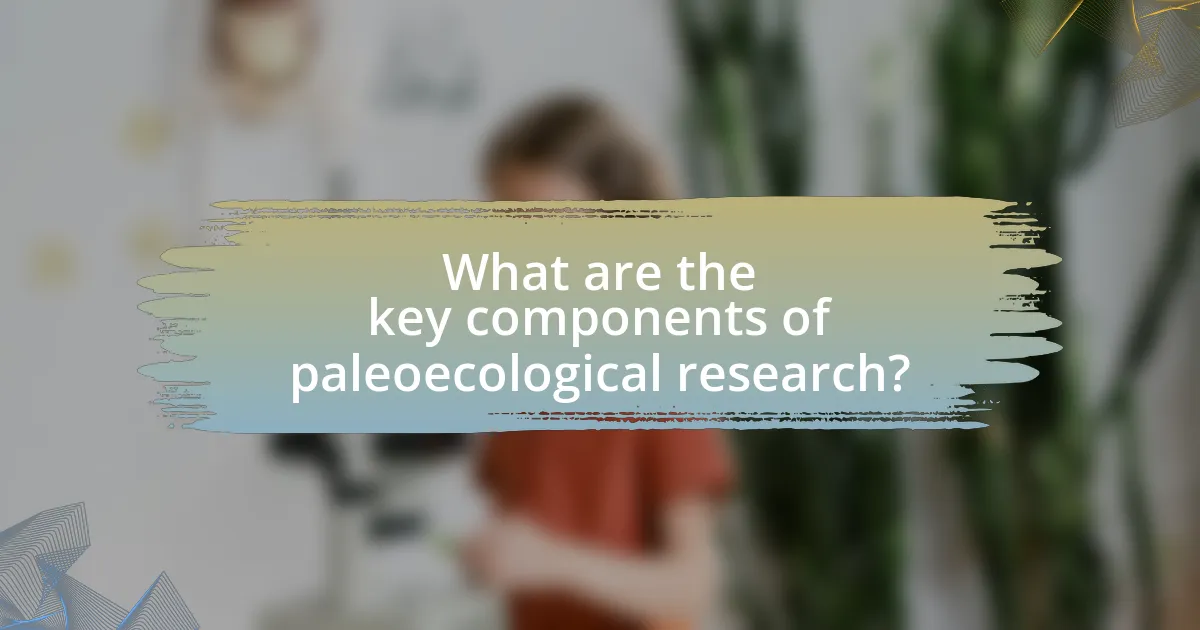
What are the key components of paleoecological research?
The key components of paleoecological research include the analysis of fossil records, sediment cores, and isotopic data to reconstruct past environments and climate conditions. Fossil records provide insights into ancient flora and fauna, while sediment cores reveal changes in sediment composition over time, indicating shifts in climate and ecosystems. Isotopic data, such as oxygen and carbon isotopes, help in understanding temperature variations and carbon cycling in historical contexts. These components collectively enable scientists to interpret ecological changes and climate variability over geological timescales.
What types of data are collected in paleoecological studies?
Paleoecological studies collect various types of data, including fossil records, sediment cores, and isotopic analyses. Fossil records provide insights into past biodiversity and species distributions, while sediment cores reveal information about historical climate conditions and environmental changes over time. Isotopic analyses, such as carbon and oxygen isotopes, help reconstruct past temperatures and precipitation patterns. These data types are essential for understanding ancient ecosystems and their responses to climate variability.
How do sediment cores contribute to our understanding of ancient environments?
Sediment cores provide crucial insights into ancient environments by preserving layers of sediment that contain biological, chemical, and physical evidence of past conditions. These cores allow scientists to analyze changes in climate, vegetation, and ocean chemistry over time, revealing patterns of environmental shifts. For instance, the analysis of foraminifera and diatoms within sediment cores can indicate historical sea surface temperatures and salinity levels, while pollen grains can inform about past vegetation and climate conditions. Studies have shown that sediment cores from locations like the Arctic and Antarctic regions have documented significant climate events, such as glacial and interglacial periods, thereby enhancing our understanding of Earth’s climatic history and ecological responses.
What role do isotopes play in reconstructing past climates?
Isotopes play a crucial role in reconstructing past climates by providing insights into temperature, precipitation, and atmospheric conditions through their ratios in various environmental samples. For instance, the ratio of oxygen isotopes (O-16 and O-18) in ice cores and marine sediments allows scientists to infer historical temperature changes, as lighter isotopes evaporate more readily and are preferentially incorporated into precipitation. Studies have shown that variations in these isotopic ratios correlate with known climate events, such as glacial and interglacial periods, thus validating their use as proxies for past climate conditions.
How do researchers analyze ancient climate data?
Researchers analyze ancient climate data primarily through the examination of proxy indicators such as ice cores, sediment layers, tree rings, and fossil records. These proxies provide indirect evidence of past climate conditions, allowing scientists to reconstruct temperature, precipitation, and atmospheric composition over geological timescales. For instance, ice cores from Greenland and Antarctica contain trapped air bubbles that reveal historical greenhouse gas concentrations, while sediment cores from ocean floors can indicate changes in ocean temperature and salinity. The analysis of these proxies often involves advanced techniques like radiocarbon dating and stable isotope analysis, which enhance the accuracy of climate reconstructions.
What statistical methods are commonly used in paleoecological studies?
Common statistical methods used in paleoecological studies include multivariate analysis, regression analysis, and time series analysis. Multivariate analysis, such as principal component analysis (PCA) and cluster analysis, helps in understanding complex relationships among multiple variables in ecological data. Regression analysis is employed to model relationships between dependent and independent variables, allowing researchers to predict ecological outcomes based on environmental changes. Time series analysis is utilized to examine temporal patterns in paleoecological data, providing insights into climate variability over time. These methods are essential for interpreting fossil records and understanding past ecosystems, as evidenced by their widespread application in studies examining ancient climate conditions and biodiversity changes.
How do researchers validate their findings in paleoecology?
Researchers validate their findings in paleoecology through multiple methods, including cross-referencing data from various proxies such as sediment cores, fossil records, and isotopic analyses. By comparing results from different sources, researchers can confirm the accuracy and reliability of their interpretations regarding ancient ecosystems and climate conditions. For instance, the alignment of pollen data from sediment cores with known climatic events provides a robust framework for validating paleoecological reconstructions. Additionally, peer review and replication studies further enhance the credibility of findings, ensuring that conclusions drawn are supported by multiple lines of evidence.
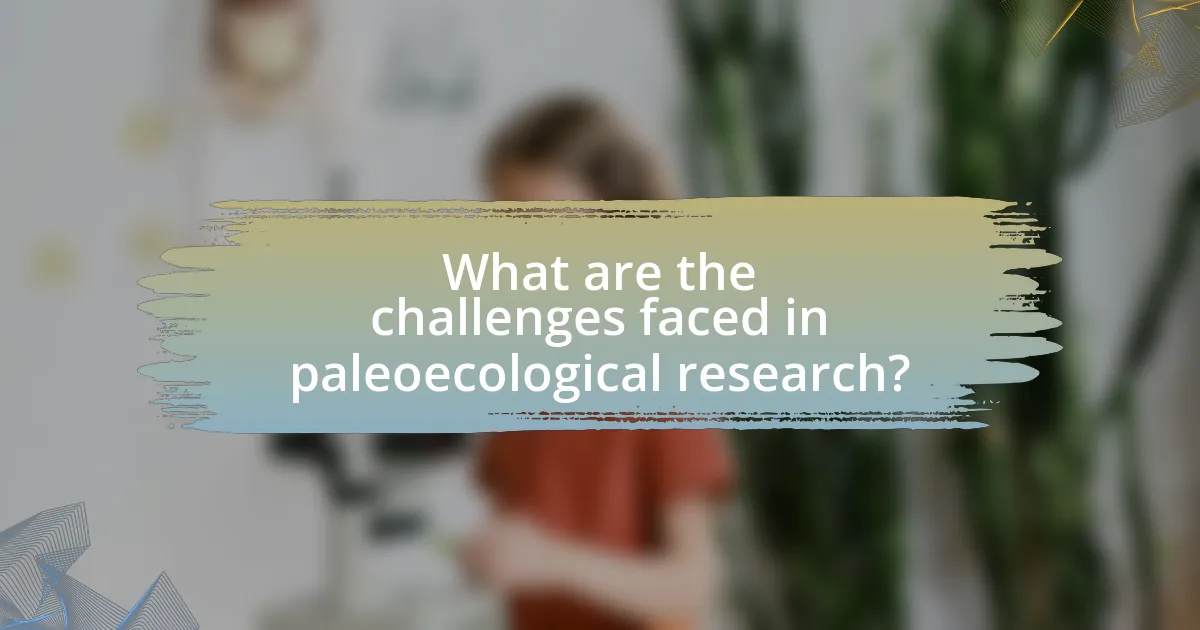
What are the challenges faced in paleoecological research?
Paleoecological research faces several challenges, including the preservation of ancient biological materials, the interpretation of proxy data, and the integration of multidisciplinary approaches. The preservation of materials such as pollen, sediments, and fossils is often limited by environmental conditions, which can lead to incomplete records. Additionally, interpreting proxy data, which serves as indirect evidence of past climates and ecosystems, requires careful calibration and understanding of the ecological context, making it complex and sometimes ambiguous. Furthermore, integrating data from various scientific disciplines, such as geology, biology, and climatology, is essential for a comprehensive understanding but can be difficult due to differing methodologies and terminologies among fields. These challenges hinder the accuracy and reliability of reconstructions of ancient climates and ecosystems.
What limitations exist in the data collected for paleoecological studies?
Data collected for paleoecological studies face several limitations, primarily related to temporal resolution, preservation bias, and representativeness. Temporal resolution is often constrained by the dating methods used, which can lead to uncertainties in the timing of ecological events. Preservation bias occurs because not all organisms or environmental conditions are equally likely to be preserved in the fossil record, resulting in incomplete data. Additionally, representativeness is an issue, as the sampled sites may not accurately reflect broader ecological patterns, limiting the generalizability of findings. These limitations can hinder the ability to draw definitive conclusions about past ecosystems and climate variability.
How do researchers address uncertainties in ancient climate reconstructions?
Researchers address uncertainties in ancient climate reconstructions by employing multiple lines of evidence, including proxy data, statistical methods, and sensitivity analyses. Proxy data, such as ice cores, tree rings, and sediment records, provide indirect indicators of past climate conditions, allowing researchers to cross-validate findings from different sources. Statistical methods, including Bayesian approaches, help quantify uncertainties by integrating various data sources and estimating the likelihood of different climate scenarios. Sensitivity analyses assess how changes in assumptions or input data affect reconstruction outcomes, thereby identifying the robustness of the results. These combined approaches enhance the reliability of ancient climate reconstructions, as demonstrated in studies like the “Paleoclimate Reconstruction Using Proxy Data” published in Nature, which highlights the importance of multi-proxy approaches in reducing uncertainty.
What are the difficulties in correlating data from different regions?
Correlating data from different regions presents challenges primarily due to variations in environmental conditions, data collection methods, and temporal scales. These discrepancies can lead to inconsistencies in the data, making it difficult to establish reliable connections. For instance, paleoecological data may be influenced by local climatic factors, geological differences, and ecological contexts that vary significantly across regions. Additionally, different methodologies used in data gathering, such as varying sampling techniques or analytical approaches, can result in incompatible datasets. Temporal mismatches, where data from different regions represent different time periods or resolutions, further complicate the correlation process. These factors collectively hinder the ability to draw accurate conclusions about ancient climate variability across diverse geographical areas.
What future directions are being explored in paleoecology?
Future directions in paleoecology include the integration of advanced technologies such as high-resolution isotopic analysis and genomic techniques to better understand ancient ecosystems. Researchers are increasingly utilizing these methods to reconstruct past climate conditions and biodiversity patterns with greater accuracy. For instance, studies have shown that isotopic data from ice cores can reveal temperature fluctuations over millennia, while ancient DNA analysis can provide insights into species interactions and migrations. These approaches are enhancing our ability to predict how current ecosystems may respond to ongoing climate change.
How is technology advancing the field of paleoecology?
Technology is advancing the field of paleoecology through the use of high-resolution imaging, molecular techniques, and data analytics. High-resolution imaging, such as X-ray computed tomography, allows researchers to visualize and analyze fossilized remains without damaging them, providing insights into ancient ecosystems. Molecular techniques, including ancient DNA analysis, enable scientists to reconstruct past biodiversity and understand species interactions over time. Additionally, advanced data analytics and modeling tools facilitate the interpretation of complex datasets, allowing for more accurate reconstructions of ancient climates and environments. These technological advancements collectively enhance the precision and scope of paleoecological research, leading to a deeper understanding of historical climate variability and ecosystem dynamics.
What interdisciplinary approaches are being integrated into paleoecological research?
Interdisciplinary approaches integrated into paleoecological research include the use of geochemistry, molecular biology, and remote sensing technologies. Geochemistry allows researchers to analyze sediment and fossil records for chemical signatures that indicate past environmental conditions. Molecular biology techniques, such as ancient DNA analysis, provide insights into past biodiversity and species interactions. Remote sensing technologies enable the mapping of historical land use and vegetation changes over time. These methods collectively enhance the understanding of ancient climate variability by providing a multi-faceted view of ecological and environmental changes throughout history.
What practical applications arise from the study of paleoecology and ancient climate variability?
The study of paleoecology and ancient climate variability has practical applications in understanding current climate change, informing conservation efforts, and guiding land-use planning. By analyzing fossil records and sediment cores, researchers can reconstruct past ecosystems and climate conditions, which helps predict future environmental changes. For instance, studies have shown that understanding historical climate patterns can improve models for forecasting climate impacts on biodiversity and agriculture. Additionally, insights gained from ancient climate data can aid in developing strategies for mitigating the effects of climate change on vulnerable ecosystems and human communities.
How can insights from paleoecology inform modern environmental policy?
Insights from paleoecology can inform modern environmental policy by providing a historical context for climate change and ecosystem responses. Paleoecological studies reveal patterns of species adaptation and ecosystem resilience over millennia, which can guide current conservation strategies. For example, research indicates that during past climate shifts, certain species migrated or adapted, while others faced extinction, highlighting the importance of biodiversity in maintaining ecosystem stability. This historical data can help policymakers anticipate potential ecological outcomes in response to current climate trends, thereby enabling more effective and proactive environmental management.
What best practices should researchers follow in paleoecological studies?
Researchers in paleoecological studies should prioritize the use of multidisciplinary approaches, integrating data from various fields such as geology, biology, and climatology. This practice enhances the accuracy of reconstructions of past environments and climate conditions. For instance, combining sediment analysis with fossil records allows for a more comprehensive understanding of ecosystem changes over time. Additionally, researchers should ensure rigorous sampling methods and statistical analyses to minimize biases and improve the reliability of their findings. Utilizing well-dated and stratified samples is crucial, as demonstrated by studies that correlate pollen data with radiocarbon dating to establish precise timelines of vegetation changes. Furthermore, transparency in data sharing and methodology fosters collaboration and reproducibility, which are essential for advancing knowledge in paleoecology.
